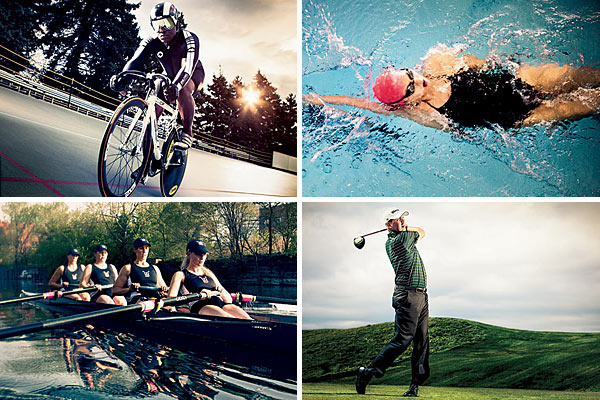
Related:
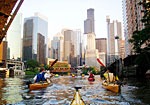
Photo tour of the best places to swim, golf, and more »
OUTDOOR SPORTS:
Boating »
Cycling »
Golf »
Swimming »
Mayor Rahm Emanuel is a workout machine. His seven-day-a-week exercise routine puts to shame that of the “country’s fittest mayor,” Minneapolis’s R. T. Rybak, who, according to Men’s Fitness, claims a mere five. Three mornings a week, Rahm wakes up early, runs to the gym, and swims a mile in a 50-meter indoor pool. Then he does chest exercises and runs two miles back to his Ravenswood Manor home. The other two mornings, he rides 25 miles on a stationary bike, followed by a 15-minute turn on the elliptical, weights, 100 sit-ups, and 50 pushups. On Saturdays,
he bikes 20 miles outdoors. What day of rest? He practices yoga on Sundays.
Compared with that, Chicago’s fitness profile is downright pathetic. We’re currently at No. 12 (behind Boston, New York, and even New Orleans) on the Alliance for Biking and Walking’s 2012 list of athletic cities. And in a recent report by the Trust for America’s Health that ranked states by adult obesity rates, Illinois actually rose a few notches, from No. 28 to No. 23, with a wince-inducing 27 percent.
Fortunately, our chief calorie burner seems intent on making all of us a little more buff. In March he greenlighted a $290 million capital improvement package that will finance new boathouses and athletic fields and the acquisition of 180 acres of open space. A big chunk, $46 million, which includes private and federal funding, will go toward finishing the 2.7-mile Bloomingdale Trail, an elevated bike path stretching from Humboldt Park to Bucktown (target completion: fall 2014). Rahm has also announced a cycling initiative that will create 25 more miles of protected lanes and will add 3,000 bikes to a public share program by late summer. When all is said and done, every Chicagoan will live within a ten-minute walk of an upgrade, the mayor says.
But there are plenty of ways to get your heart pumping outside right now. We zeroed in on four sports—cycling, swimming, boating, and golf—that are popular, best enjoyed in the summertime, and, when done right, make you sweat (no golf carts!). We asked a standout athlete from each to serve as our guides. They shared their personal regimens, gave some pointers, and recommended top spots for novices. We rounded out their picks with our own for a range of fitness levels and budgets. Jump right in—Chicago will get in shape in no time.
Photography: (all) Brian Kuhlmann; Assistants: (top right): Colin Beckett, Lauren Butterfield, Sarah Bruchman. (All others) Colin Beckett, John Ruzich; Stylist: Nicole Cap/Ford Artists. Location (bottom right): Harborside International Golf Center.
CYCLING
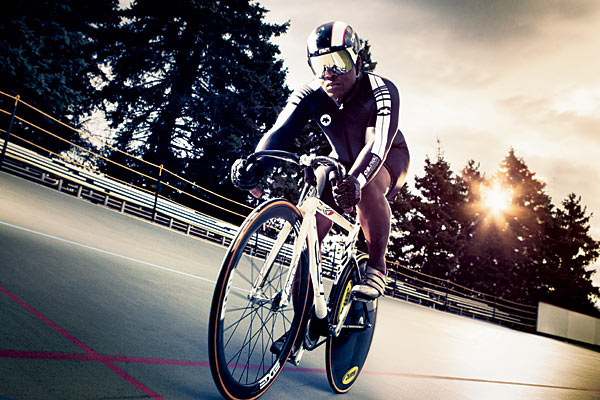
Related:

Photo tour of the best places to swim, golf, and more »
MORE OUTDOOR SPORTS:
Boating »
Golf »
Swimming »
EDMUND WHITE, 32
Silver medalist at the Illinois State Sprint Championship; member of the Bouledogue Tout Noir cycling team
REGIMEN
A track cyclist who competes in short sprints that can clock in at 42 miles per hour, White has devised a competition-prep routine that takes him to the velodrome, the road, and the gym. He kicks off on Wednesdays, his heaviest training day, at Evanston Athletic Club, where he spends an hour doing squats, seated box jumps, dead lifts, and core work. Wednesday evenings, he participates in a group ride that leaves from Turin, a bike shop in Evanston, and covers 40 miles to Lake Forest and back. “That one is at nearly race pace,” White says. “We’ll go 28 to 30 miles an hour for certain stretches.”
BEST BICYCLING ROUTES
1. FOR ROAD CYCLISTS: White recommends that road bikers of all stripes build up speed on the stretch of Sheridan Road from Evanston to Lake Bluff, with its views of the lake and gorgeous manses and, most important, its flat terrain. Sheridan will take you all the way to Wisconsin, but it’s especially biker-friendly—in good condition, not as congested—through Lake Bluff. Start early on a weekend morning before traffic builds. EXPERT PICK
2. FOR BEGINNERS: The tree-lined, partially paved North Branch Trail starts at Devon and Caldwell Avenues (if you’re driving, park at entrance 1, 2, or 3 at Caldwell Woods Grove) and snakes north 17 miles to the Chicago Botanic Garden, where bike racks are provided for those who want to stop and smell the roses. Families with younger children can drive to the Skokie Lagoons (there’s a parking lot on Tower Road) and pick up the breezy four-mile trail loop that encircles the manmade lagoons. At the north end, it’s only a quick jaunt across Dundee Road to the botanic garden. fpdcc.com
3. FOR BUDDING DISTANCE RIDERS: A good way to build stamina and accumulate mileage is to ride with a group. One of the most accommodating is the XXX Racing–AthletiCo No-Drop Ride (no rider left behind!), which starts at 7 a.m. every Saturday in Wicker Park and goes nearly 50 miles, to Highland Park and back. Faster cyclists often split from the group in Highland Park to take spirited extensions farther north. xxxracing.org
4. FOR LEISURE RIDERS: The beautiful Fox River Trail meanders through picturesque prairie for much of its 39 miles between Algonquin and Oswego, but the highlight is the 17.5-mile stretch that starts in Elgin at the Trout Park Nature Preserve and heads south to the Fabyan Forest Preserve in Geneva. There you’ll find a restored Dutch windmill and a traditional Japanese garden. Pack a picnic—what was once a bear cage on the grounds is now a pavilion lined with flowers. kaneforest.com
5. FOR CHALLENGE SEEKERS: The hilly northwestern suburb of Barrington offers road cyclists several options with inclines. One favorite is the Barrington Bicycle Club’s 25-mile loop, which rolls along the western edge of the Spring Creek Valley Forest Preserve for more than three miles and peaks along Haegers Bend Road, at 880 feet above sea level. Access the loop via Barrington High School’s parking lot—ditch the car there and take County Line Road east before going south on Dundee Avenue. barringtonbikeclub.com
EXPERT ADVICE: HOW TO GET THE MOST OUT OF YOUR PEDAL
White suggests using toe clips and straps, or clipless pedals to increase foot retention and maximize efficiency.
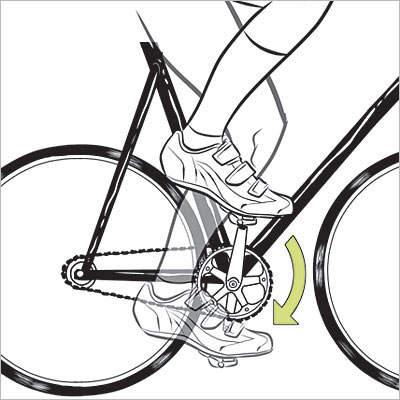
(1) With your feet at noon and six, push down with your leg, not your foot. Slightly bend your knee even at the fullest extension.
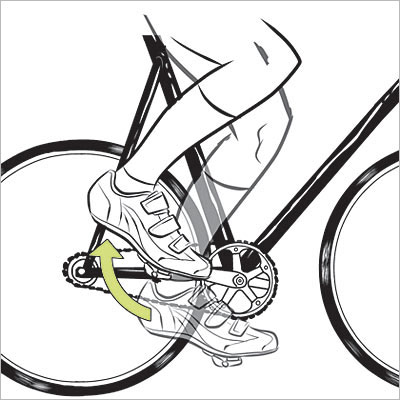
(2) From six to nine, pull upward. “Forty percent of my stroke is a pull, which helps me conserve energy,” White says.
Photograph: Brian Kuhlmann; Assistants: Colin Beckett, John Ruzich; Stylist: Nicole Cap/Ford Artists
SWIMMING
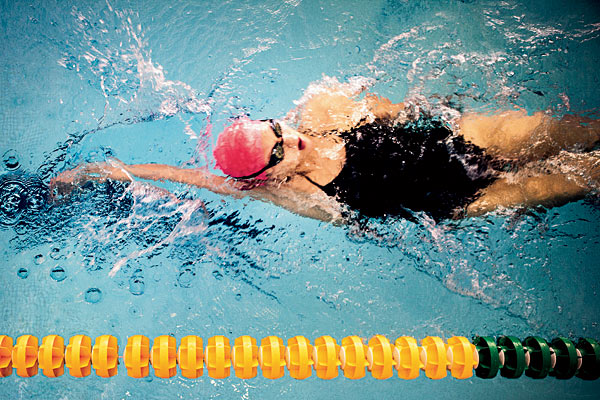
Related:

Photo tour of the best places to swim, golf, and more »
MORE OUTDOOR SPORTS:
Boating »
Cycling »
Golf »
OLIVIA SMOLIGA, 17
National medalist and state record holder in freestyle (50 and 100 yards) and backstroke (100 yards); competes this month at the Olympic trials in free (50 and 100 meters) and back (100 and 200 meters)
REGIMEN
Training for the Olympic trials means nine practices a week for this student at Glenbrook South High School. Mondays are the busiest: She wakes at 5 a.m. for a 90-minute practice at the school’s indoor pool. “Those are power days,” Smoliga says, “where we work on sprinting—the breakout, the turn, and the finish.” That’s in addition to muscle-toning exercises, such as swimming underwater with resistance bands. Three afternoons a week, she heads to Rebound Fitness, a sports medicine clinic in Northbrook, where she cross-trains with boxing, running, and weightlifting. Then it’s back to school for a two-hour evening practice, where the focus is on cardio and yardage.
BEST SWIMMING SPOTS
1. FOR LAP SWIMMERS: When Smoliga wants to practice outside, her coach takes her to Deerspring Pool in Deerfield. The Olympic-size L-shaped pool features six lap lanes, and dedicated adult swim hours are offered. For kids, there’s a “sprayground” and a zero-depth wading pool. 200 Deerfield Rd., Deerfield; 847-945-7610, deerfieldparks.org. Opens June 2. $7 (free for kids under four) EXPERT PICK
2. FOR ADULTS IN THE CITY: The Olympic-size outdoor pool in Portage Park, where Mark Spitz set three world records at the Olympic trials in 1972, draws North Siders with its regular morning adult swim hours (7 to 9 a.m. weekdays) and free weekly aqua aerobics classes. 4100 N. Long Ave.; 773-685-7235, chicagoparkdistrict.com. Opens June 15. Free
3. FOR LAKE SWIMMERS: One of the few local beaches with a dedicated play zone for kids, Glencoe Beach doubled its swim area this season—and even rents kayaks. Occasional evening concerts and camp-outs keep the fun going after sunset. 55 Hazel Ave., Glencoe; 847-835-1185, glencoeparkdistrict.com. Opens Memorial Day weekend. $10 (free for kids under one)
4. FOR CROSS-TRAINERS: Anyone who’s bored with laps but still craves low-impact workouts will love Orland Park’s Centennial Park Aquatic Center. You can walk against the current of the lazy river from 6:30 to 8 a.m. Or break an underwater sweat at the new Aqua Zumba classes on Tuesdays and Thursdays. 15600 West Ave., Orland Park; 708-349-4386, orland-park.il.us. Opens Memorial Day weekend. $3 to $14
5. FOR FAMILIES: Parents in the know recommend Cypress Cove Family Aquatic Center in Woodridge for a water park experience at a reasonable price. It’s a slam dunk for swimmers of all levels: Older kids can coast down the six water slides (three body slides, a tube slide, a drop slide, and a kiddie slide) while tots splash around in the 600-foot lazy river and zero-depth pool. Parents looking for a quick workout (or just a moment of peace) can steal some time in the six-lane lap pool. 8301 S. Janes Ave., Woodridge; 630-985-5620, cypresscove.org. Opens Memorial Day weekend. $4 to $13 (free for kids under one)
EXPERT ADVICE: HOW TO DO A FLIP TURN
Many swimmers are scared of flip turns—and that’s an unnecessary fear, says Smoliga.
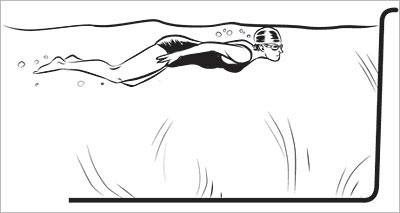
(1) When you’re an arm’s length from the wall, drop both arms to your sides as you glide into the wall.
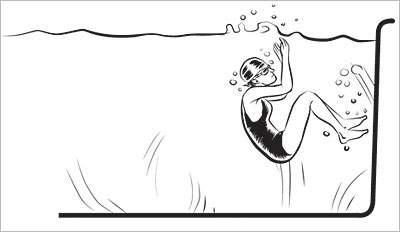
(2) Duck your head into your chest and bring your knees up, curling yourself into a ball. Flip. “It’s a somersault in the water,” Smoliga says. Finish your flip with your bent legs at the wall.
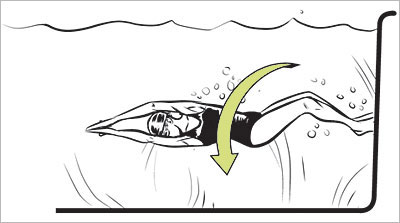
(3) Push off with your feet, one hand over the other in front of you. Do a pencil twist to end up back on your stomach.
Photograph: Brian Kuhlmann; Assistants: Colin Beckett, Lauren Butterfield, Sarah Bruchman; Illustrations: John Kenzie
BOATING
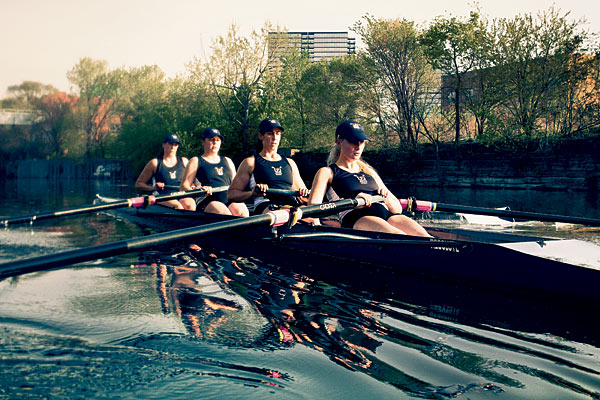
Related:

Photo tour of the best places to swim, golf, and more »
MORE OUTDOOR SPORTS:
Cycling »
Golf »
Swimming »
MORGAN FUNKE, 31
C.R.A.S.H.-B world rowing indoor champion (master women); member, LPJ Chicago Masters rowing team (pictured second from front)
REGIMEN
Funke’s gold-medal-winning crew team practices three nights a week on the Chicago River and once indoors. Practice starts at 6:15, and the team rows until 8 or 8:30, depending on the light, completing an eight- to ten-kilometer route through the Loop to Chinatown. Funke, who’s also training for the Ironman competition, supplements with workouts at RowFit, a rowing and CrossFit gym in West Town. “I’m at the gym at 6 a.m.,” she says, “often doing Rowing Boot Camp,” which consists of two- to five-minute rowing intervals interspersed with lunges, kettle swings, and jumping rope. To cross-train, she runs or bikes.
BEST BOATING
1. FOR BEGINNING ROWERS: The Frances K. Mennone and Bruce H. Smith Floating Boathouse in Lincoln Park holds six-week Learn to Row classes that gently, but thoroughly, tutor newcomers. “It starts with the basics,” Funke says. “By the time you get on the water, you feel really prepared and knowledgeable.” The next session runs May 29 to July 3. North Avenue and Kingsbury Street (enter from the Old Navy parking lot); lpjchicago.com. From $125 EXPERT PICK
2. FOR KAYAKERS: There are plenty of spots to rent a kayak, but Kayak Chicago goes a step further, offering guided tours, lessons (from intro to advanced), and rentals at three locations: the Chicago River (near the intersection of Le Moyne Street and Magnolia Avenue), Montrose Beach, and North Avenue Beach. We’re partial to the night paddle, a guided three-hour tour during which you can admire the reflection of city lights on the river. 630-336-7245, kayakchicago.com. Rentals from $20 an hour; tours from $55
3. FOR CANOERS: Reed’s Canoe Trips sends paddlers down the Kankakee River, a beginner-friendly Class I waterway (a few ripples and small waves) that offers enough scenery and wildlife to keep more experienced boaters entertained. Reed’s provides 17-foot canoes, paddles, life jackets, and transportation (park at the headquarters at 907 North Indiana Avenue in Kankakee). Our pick: a 12-mile tour that winds through the state park. 815-932-2663, reedscanoetrips.com. Tours from $56
4. FOR PADDLEBOARDERS: The only one-stop paddleboard shop in the city, the Great Lakes Board Company brings a laid-back California vibe to North Avenue Beach. For the uninitiated, paddleboarding is a great workout: Try SUPyo, Great Lakes’ yoga-meets-paddleboard hybrid, where students practice poses like side plank or tabletop while balancing on a floating board. On the bike path, south of Castaways Bar and Grill; 773-575-4787, greatlakesboardcompany.com. Rentals from $25 an hour
EXPERT ADVICE: HOW TO EXECUTE A POWER STROKE
“A lot of people think that rowing is upper body, but it is a leg-dominant sport,” Funke says. The perfect stroke can be broken down into three parts: legs, body, arms.
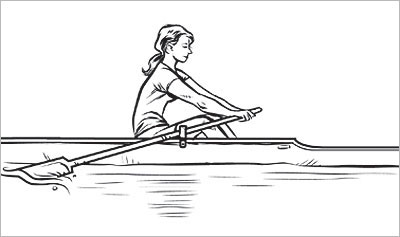
(1) Start seated with your knees at your chest, arms straight, body forward.
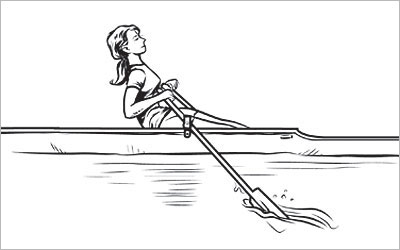
(2) Push your heels down and shoot your legs straight. Swing your core back so you are sitting with your torso at 11 o’clock.
(3) Finish by bringing your arms into your chest.
Photograph: Brian Kuhlmann; Assistants: Colin Beckett, John Ruzich; Stylist: Nicole Cap/Ford Artists; Illustrations: John Kenzie
GOLF
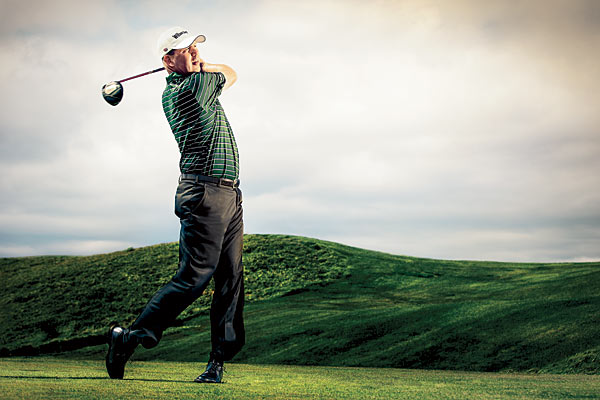
Related:

Photo tour of the best places to swim, golf, and more »
MORE OUTDOOR SPORTS:
Boating »
Cycling »
Swimming »
MIKE SMALL, 46
Three-time PGA professional national champion and two-time low club pro at the PGA Championship; head golf coach at University of Illinois
REGIMEN
After the collegiate season is over, Small spends at least an hour a day focused on putting and chipping. “I’ve competed in probably 75 PGA Tour events, so I know how to play, but I need to have my fundamentals solid,” says the golfer, who in June heads to the Professional National Championship at the Bayonet and Black Horse Golf Courses in California. To stay tour-ready, Small devotes two to three hours a week to cardio, stretching, and core strengthening. For cardio, Small opts for the stair stepper, which he says is easier on his lower back than running. His core workouts consist largely of crunches, reverse crunches, planks, side planks, and back hyperextensions. “I also use resistance bands to work the upper back,” Small says. “That’s where the posture happens. Golf is a rotary sport, so your back needs to be able to handle the load.”
BEST GOLF COURSES
1. FOR NORTH SIDERS On the former site of the Glenview Naval Air Station, The Glen Club is the best public course in the area for players of all skill levels. Pat Goss, the men’s golf coach at Northwestern University, says he recommends it because “it’s a public experience with the private feel”—down to the courteous staff and the architecture of the 7,149-yard par-72 course. (Public) 2901 W. Lake Ave., Glenview; 847-724-7272, theglenclub.com. $105 to $185 for 18 holes
2. FOR SOUTH SIDERS The 36-hole Harborside International Golf Center has modest origins: It was built on a 250-acre trash dump. But the par-72 course offers great views of the city, is less than 20 minutes from the Loop, and has discounted greens fees of $57 (for 18 holes) if you tee off after 3:30 on a weekday. (Public) 11001 S. Doty Ave. East; 312-782-7837, harborsideinternational.com. $57 to $95 for 18 holes
3. FOR THOSE WHO NEED PRACTICE Cog Hill in south suburban Lemont boasts Dubsdread—a challenging 7,554-yard par-71 course that’s a regular stop on the PGA Tour—and a stellar practice facility and learning center, which operates the No Embarrassment Golf School. Golfers who need to pay attention to their short game will appreciate that the 8,000-square-foot putting green is open 364 days a year. (Public) 12294 Archer Ave., Lemont; 866-264-4455, coghillgolf.com. $155 (Dubsdread) for 18 holes
4. FOR GOLFERS DYING TO PLAY A MAJOR Whenever Small drives up I-57 from Champaign to Chicago, he stops at the Olympia Fields Country Club to play a round. “We host the Fighting Illini Invitational there, and they hosted the U.S. Open in 2003,” Small says. Of the club’s two 18-hole options, go for the 7,205-yard par-70 North Course: Last year, it ranked 60th on Golf Digest’s list of the 100 greatest courses in America. “I love it because it’s not monotonous,” Small says. “No hole is like another.” The club is invite-only, but golfers in the know say it often hosts charity events; donate to a good cause and boom!—it’s tee time. (Private) 2800 Country Club Dr., Olympia Fields; 708-748-0495, ofcc.info EXPERT PICK
5. FOR LUKE DONALD FANS Chicago’s own Donald—at presstime, the No. 1–ranked golfer in the world—is most closely affiliated with Conway Farms, a 7,216-yard par-71 course that will host the 2013 BMW Championship. Goss, who is Donald’s swing coach, says it’s a favorite because of its “wonderful practice area and driving range—and it is hard enough to host a PGA event and challenge the players.” Membership is by invitation only—but you can buddy up to a member and go as a guest. (Private) 425 S. Conway Farms Dr., Lake Forest; 847-234-6979, conwayfarmsgolfclub.org
6. FOR COURSE DESIGN SNOBS Founded in 1894, the 6,846-yard par-70 Chicago Golf Club in Wheaton is the oldest 18-hole course in North America and was one of five founding clubs of the United States Golf Association. It’s also one of the toughest in the country to get onto and play. Golfers say there’s no real secret to nabbing an invitation, but club membership is small, so you really have to work your connections. (Private) 25W253 Warrenville Rd., Wheaton; 630-665-2988
EXPERT ADVICE: HOW TO PUTT MORE ACCURATELY
Novices tend to spend too much time on the range and not enough on their short game, Small says. His advice: “Learn the game from the hole backward.”
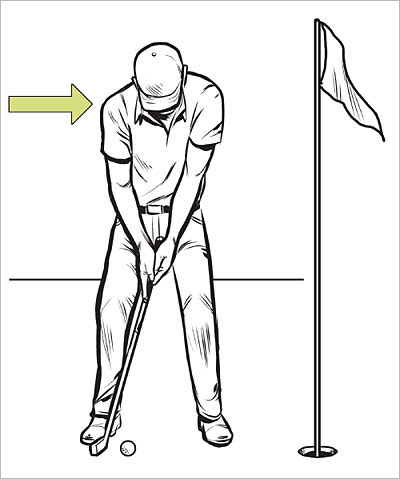
(1) Place your thumbs on top of the shaft, with your hands facing each other.
(2) Focus on your stance, making sure your putter face is square to the hole and your shoulders are lined up to the target line. Explains Small: “Shoulder alignment will dictate the path of the putt. If your shoulders are open, they will work independently of the putter, and you’ll likely put spin on the ball.”
Photograph: Brian Kuhlmann; Assistants: Colin Beckett, John Ruzich Stylist: Nicole Cap/Ford Artists; Location: Harborside International Golf Center; Illustrations: John Kenzie


